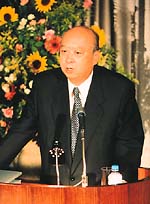|
 Digital
Broadcasting Digital
Broadcasting
We are presently putting the greatest emphasis on launching digital satellite broadcasting this December, and are determined to make it a success. Building on this foundation, we will then concentrate on digital terrestrial broadcasting, which is scheduled to start at the end of the year 2003. In a step-by-step fashion, digital broadcasting experiments have been steadily conducted in Japan. Although the broadcasting frequencies for Japanese terrestrial broadcasting services are extremely congested, we are developing a digital terrestrial broadcasting Channel Plan to permit the coexistence of the new digital terrestrial and existing analog terrestrial TV broadcasting systems.
Hi-Vision (HDTV)
In Europe, since multi-channel television broadcasting is already well established, it is forecast that the introduction of HDTV broadcasting will take a fairly long time. In the United States, although HDTV broadcasting has already started, the program production capabilities are not yet well established. At NHK, we are aggressively working to promote the diffusion of HDTV in the confidence that HDTV will become the core medium of the 21st century. In recognition of our accomplishments, NHK has been assigned to conduct live HDTV broadcasting from several important international events, including the national conventions for the Republican and Democratic Parties for the U.S. presidential campaign, and the United Nations millennium summit meeting in September, attended by leaders from all over the world. This again shows that NHK has global recognition for its technological expertise.
The Internet
Broadcasting via the Internet, now considered the third main medium, has become an international trend. As new mobile terminals such as the IMT2000 appear in the market, the receipt of visual information on a mobile terminal will also be possible. Such media would become a lifeline in times of emergency. It is only natural to make NHK's programs available through every possible transmission means and to use the various tools available for viewing and listening. The use of only domestic TVs and radios may not provide people with adequate information. We believe that it is one of the public broadcaster's missions to extend universal services to the new types of information terminals, thus realizing broadcasting with as few barriers as possible, making information available anytime, anywhere, for everybody.
ISDB (Integrated Services Digital Broadcasting)
Digital broadcasting on ISDB will feature HDTV and new data broadcasting
services. ISDB receivers will also be equipped with capabilities such
as Internet access and a communications function that includes interactivity.
In addition, its built-in home server will store broadcasting and communications
services that can be called up for use at any time. The concept of ISDB
is to make various services available by utilizing digital technology
in a user-friendly manner through simple, easy-to-understand graphics.
Full-scale research on ISDB started in 1983, and NHK has been confidently
proposing the ISDB service system to the world since 1985. This research
and development has a long history (See "History
of ISDB Research and Development") , and is finally reaching the
point of realization.
Research and Development Efforts
We are constantly tackling research on fundamental technologies with a view towards applications that we foresee 10, 20, and even 30 years hence. On the research theme of "human-friendly broadcasting services," we have recently inaugurated such trial automated services as Japanese-English translation and closed-captioning. We have also developed tools to assist the elderly, including a speech rate converter. Research and development is also progressing on both a large-screen ultra-high-definition TV with 4,000 scanning lines, to realize higher definition than the current Hi-Vision (HDTV) TVs, and 3-D TV systems which do not require special glasses for viewing. With the NHK Science & Technical Research Laboratories' 70-year history, we are confident of our role as one of the most advanced laboratories in the world. We are determined to apply our technological accomplishments to the progress of broadcasting, propounding the notion that "broadcasting is culture" and constantly providing truly useful broadcasting services for viewers both present and future. |



 Digital
Broadcasting
Digital
Broadcasting Teletext
broadcasting begins.
Teletext
broadcasting begins.